
Feeding bees in the fall
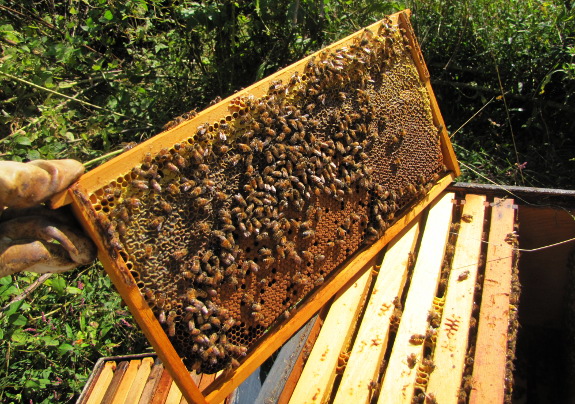
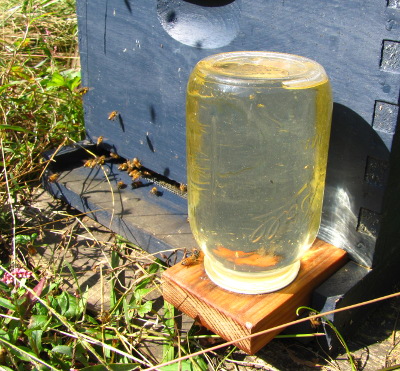 I started feeding sugar water
to our daughter
hive a week ago
because I figured they just weren't going to sock away enough honey
before weather cools to the point that the bees won't be able to
dehydrate nectar. My philosophy on feeding bees is well summed up
by the quote below, and by the website I snagged
it from, but
sometimes you've just gotta do what you've just gotta do.
I started feeding sugar water
to our daughter
hive a week ago
because I figured they just weren't going to sock away enough honey
before weather cools to the point that the bees won't be able to
dehydrate nectar. My philosophy on feeding bees is well summed up
by the quote below, and by the website I snagged
it from, but
sometimes you've just gotta do what you've just gotta do.
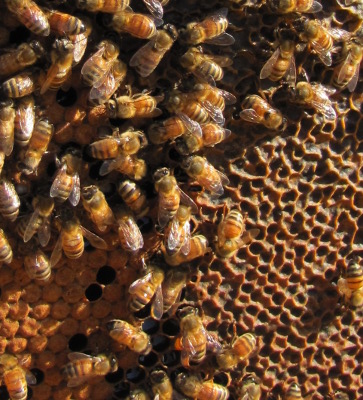 Since my goal is to get as
much honey into the hive as fast as possible, I've been feeding a
roughly 2:1 sugar to water solution made by dissolving 3.5 cups of
sugar in just shy of 2 cups of water. I heat the mixture gently
on the stove until the sugar dissolves (being careful not to let the
sugar caramelize, which can harm the bees), then pour the syrup into a
quart jar with a special top. Finally, I up-end the jar into a
front feeder.
Since my goal is to get as
much honey into the hive as fast as possible, I've been feeding a
roughly 2:1 sugar to water solution made by dissolving 3.5 cups of
sugar in just shy of 2 cups of water. I heat the mixture gently
on the stove until the sugar dissolves (being careful not to let the
sugar caramelize, which can harm the bees), then pour the syrup into a
quart jar with a special top. Finally, I up-end the jar into a
front feeder.
The feeder is a simple
but elegant design that allows me to see how much syrup the bees have
taken (they tend to use up a quart in 24 hours) and to feed our hive
without putting on a bee suit. Meanwhile, the feeder doesn't
stimulate robbing since it opens directly into the hive and isn't
accessible to neighboring bees.
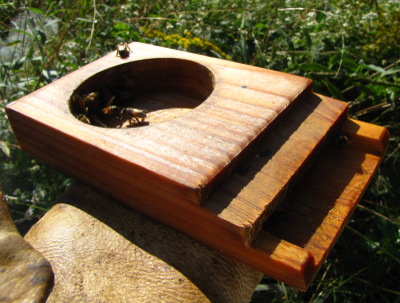
Two weeks ago, the
daughter hive had 12.25 pounds of capped honey, and after feeding them
around 11 pounds of sugar (plus water), they've gained 15.5
pounds. Since the unfed mother hive gained 8.5 pounds of honey in
that time, I suspect the sugar water turned into about 7 pounds of
honey. (You do tend to get a bit less weight of capped honey than
you put in as sugar.)
With 38.5 pounds and 28
pounds, respectively, of capped honey in the mother and daughter hives,
we've still got a ways to go if we want to meet the bare minimum 50 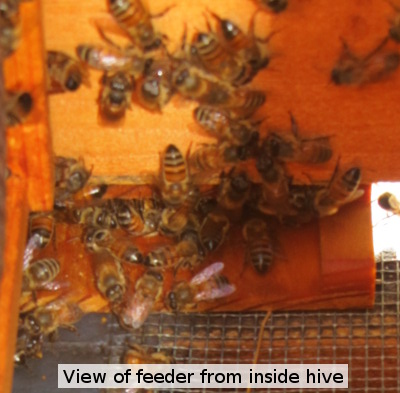 pounds required for winter
survival in our area. We're currently having a nice fall nectar
flow and there is quite a bit of nectar dehyrating in both hives, but
it still might require another week or two of constant feeding to get
the daughter hive up to weight. I'll do another honey count next
week and might even start feeding the mother hive if she's still low
--- I'm bound and determined to send two healthy hives into the winter.
pounds required for winter
survival in our area. We're currently having a nice fall nectar
flow and there is quite a bit of nectar dehyrating in both hives, but
it still might require another week or two of constant feeding to get
the daughter hive up to weight. I'll do another honey count next
week and might even start feeding the mother hive if she's still low
--- I'm bound and determined to send two healthy hives into the winter.
Want more in-depth information? Browse through our books.
Or explore more posts by date or by subject.
About us: Anna Hess and Mark Hamilton spent over a decade living self-sufficiently in the mountains of Virginia before moving north to start over from scratch in the foothills of Ohio. They've experimented with permaculture, no-till gardening, trailersteading, home-based microbusinesses and much more, writing about their adventures in both blogs and books.
Want to be notified when new comments are posted on this page? Click on the RSS button after you add a comment to subscribe to the comment feed, or simply check the box beside "email replies to me" while writing your comment.

I highly recommend bees. They are less intuitive than other types of livestock, but they also take so much less time. If I were a new homesteader, I'd probably get livestock in this order:
One thing to keep in mind is that you don't need to provide all of the forage for your bees. They regularly fly up to a mile and will fly up to eight miles if necessary to get fed. A quick glimpse of your website suggests that you've got some wild areas closeby, and these areas do tend to provide quite a bit of spring and fall nectar and pollen. Chances are, you've got plenty of bee food closeby for a hive or two.